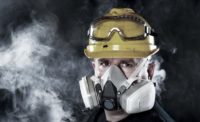
Not all cartridge service life calculators are the same. Before using a service life calculation tool, there are some things you should consider. 29 CFR 1910.134 requires users of air purifying cartridges to determine a change-out schedule to avoid worker overexposure. A user cannot rely on odor thresholds and other warning properties as the basis for determining change out. The change schedules must be based on the exposure assessment and information resulting from experimental data, mathematically based estimates, and/or reliable use recommendations from the employer’s respirator suppliers. In most cases, a manufacturer-maintained service life calculator is all that is available.
Industrial air purifying cartridges use highly active microporous sorbent materials. Toxic contaminants are captured physically or chemically by the sorbent. Service life calculation requires the blending of physics and regulatory know-how. Consider these five essentials before using a service life calculation tool.
1. Contaminant physical properties
Volatility is the contaminant physical property that most affects service life. The volatility of a contaminant is its tendency to be present as a vapor in air. Volatility is a function of the contaminant vapor pressure and boiling point. Highly volatile contaminants tend to be poorly retained and have very short service lives without special reactive sorbents. In addition to volatility, the dipole moment (polarizability) and water solubility determines the equilibrium amount of the contaminant that can be retained on the cartridge.
2. Site conditions
Worksite conditions dramatically influence service life. What was an acceptable change-out schedule for morning operations in winter may not be acceptable for afternoon operations in summer.
Atmospheric pressure changes the contaminant’s relative volatility. This is similar to the boiling point depression of water at high altitudes. Lower pressures at high altitudes slightly lengthen service life.
Temperature heavily influences the cartridge capacity. Hot temperatures lead to shortened service life while cooler temperatures lead to relatively smaller increases in service life.
Relative humidity is a major driver of service life. The amount of water on the cartridge sorbent is directly proportional to the relative humidity. For water insoluble organic vapors like cyclohexane and carbon tetrachloride, the adsorbed water directly competes for sorption capacity and shortens service life. For many acid gases, adsorbed water helps to hydrolyze and capture the contaminants lengthening service life.
Workrate (airflow) affects the amount of the contaminant that the cartridge must filter and the uptake rate of the cartridge sorbent. Service life increases linearly with the inverse of the airflow rate. Most service life calculators include several breathing rates or work rate presets.
Contaminant concentration as determined by a worksite exposure study is a primary driver of service life. Higher concentrations of contaminants are more readily captured but quickly overwhelm the cartridge. Lower concentrations are less efficiently captured but take longer to expend cartridge capacity.
Air purifying cartridges must never be used in cases where the contaminant concentration is above a level Immediately Dangerous to Life and Health (IDLH) or the Maximum Use Concentration (MUC). The MUC is the product of the Assigned Protection Factor (APF) of the selected respirator and the occupational exposure limit of the contaminant. It is important to note not all service life calculation tools automatically check the entered concentration against MUC and IDLH.
3. Multiple contaminants
Multiple contaminants can severely degrade service life. Beware of calculators that allow calculation of service life for multiple contaminants of different gas types. While multi-contaminant effects of organic vapors are generally understood, gases of different types like acid gases and organic vapors will compete for sorption space in unexpected ways.
4. Specific regulatory limited chemicals
Superseding any service life calculation result are the OSHA respirator requirements found in substance-specific standards like 1910.1028 for benzene. OSHA substance-specific standards may require specific respirator types based on contaminant concentration, provide minimum service life requirements and maximum change-out intervals for cartridges. OSHA has established substance-specific standards for 30 substances that it has identified as unique and in need of specific guidance.
5. Safety factors
Safety factors are used to account for calculation inaccuracies but also allow the user sufficient time to exit the contaminated area prior to cartridge change out. The exposure limit, accuracy of the calculation under specific conditions and the effect of site condition variability should be factored in to achieve a smart safety factor.
Setting the breakthrough limit to a percentage of the exposure limit adds a false sense of security. The majority of contaminants break through rapidly, and calculated service life changes vary little except when the breakthrough limit is set to a fraction of the exposure limit. Selection of an exposure limit should be driven by toxicological reasons, not to add a safety margin to service life.
The accuracy of service life calculations worsens for the following conditions: hot-humid conditions, high flow rates and multiple contaminants. Extra caution should be observed under these scenarios.
Site conditions depend on measured values from the field. It is rare that these measurements are as precise as desired. How these variations affect service life highly depends on the type of cartridge and the specific type of contaminant. It is important that the service life calculator you use allows entering estimated error for site variables and provides a worstcase calculation based on your scenario.
Air purifying respirators
Regardless of the accuracy of the service life calculation, many other factors determine if use of an air purifying respirator is suitable. Oxygen deficiency, oxygen enrichment, asphyxiants, contaminant levels immediately dangerous to life or health, potentially corrosive and/or explosive atmospheres, potentially permeating contaminants and climatic extremes all need to be considered prior to assuming suitability and generating a change-out schedule.
Calculating service life does not have to be difficult. By considering these five essentials before using a service life calculator, you can be sure about service life.

